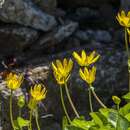Biology
provided by Arkive
The flowers of lesser celandine close just before it begins to rain, and are only open between 9 am and 5 pm (5). They are pollinated by bees, flies and beetles (2), but very few seeds are typically set (5). This perennial plant remains in full bloom throughout March and April but begins to fade in early summer (5). The plant dies back during May, and remains dormant throughout the rest of summer, autumn, and winter, with nutrients stored in the underground root-tubers (5). These tubers allow the plant to spread quickly in disturbed areas - they break away from the roots and give rise to new plants. The subspecies bulbifer can also spread by means of the tuberous bulb-like structures it produces at the junction between plant stem and leaf stem (4).
Conservation
provided by Arkive
Conservation action is not required for this species.
Description
provided by Arkive
As the local name 'spring messenger' suggests, lesser celandine is one of the first flowers of the year (4). Its bright buttery yellow flowers are a cheering sight in the middle of February, brightening hedgerows and woodlands alike (5). The roughly heart-shaped leaves, which appear just before the flowers, are dark green, shiny and fleshy, and are often mottled with patches of darker green (2). The plant grows from root-tubers, which are said to look like bunches of figs. This explains the scientific name of the plant, ficaria, which is Latin for fig. Another alternative name of this celandine, pilewort, also derives from the appearance of these knobbly tubers. Their general similarity to haemorrhoids led to the plant being widely used to treat this condition (4). There are two native subspecies in Britain, Ranunculus ficaria ficaria and Ranunculus ficaria bulbifer . The latter bears tuberous bulb-like structures known as 'bulbils' at the points where the leaf stalks meet the main stem of the plant (3).
Habitat
provided by Arkive
Lesser celandine is found in a range of habitats, including woodlands, hedgerows, churchyards, road verges, meadows, in gardens and waste ground and on river banks (2) (3). Subspecies ficaria tends to thrive better in less disturbed habitats than subspecies bulbifer (3).
Range
provided by Arkive
Subspecies ficaria has a wide distribution throughout the British Isles, becoming scarcer in Scotland. Subspecies bulbifer has a more eastern distribution, and is fairly rare around the western coasts of Britain. Both subspecies are widespread in Europe (2).
Status
provided by Arkive
Not threatened (3).
Threats
provided by Arkive
This plant is not threatened.
Associations
provided by BioImages, the virtual fieldguide, UK
Foodplant / parasite
amphigenous telium of Uromyces ficariae parasitises live leaf of Ficaria verna ssp. verna
Remarks: season: 3-5

